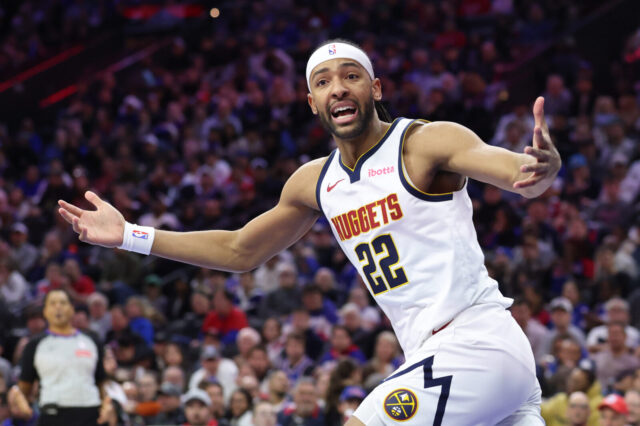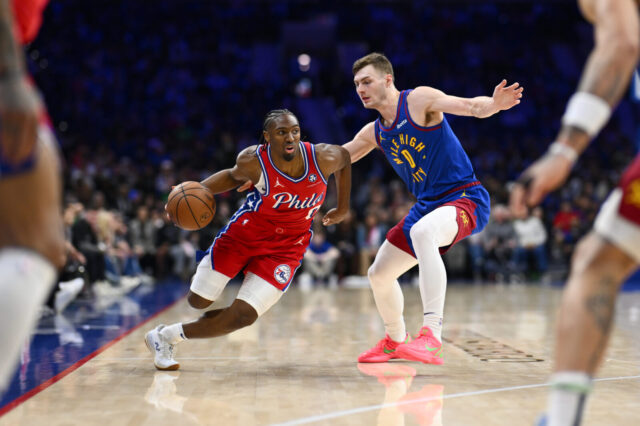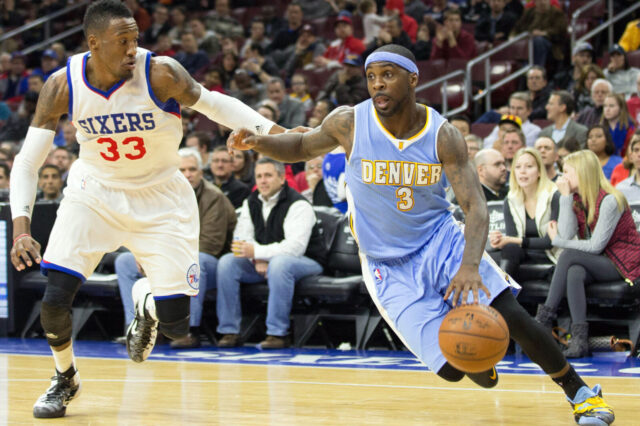What if I told you the Denver Nuggets used to have the purest shooter in the league? You’d think Alex English right? Well, in the 1990s there was no more pure, smooth, quick shooting stroke than that of Mahmoud Abdul-Rauf’s.
What if I was to tell you that the closest comparison to Rauf is Stephen Curry?
Below is a synopsis of how one player overcame immense physical, emotional and social odds to become one of the best shooters in the 90s – and how refusing to stand up destroyed his NBA career.
***
March of 1996 – Denver, Colorado
Mahmoud Abdul-Rauf always seemed agitated during the national anthem before NBA games. This agitation grew worse and worse until, suddenly, Rauf was seen sitting on the bench during the National Anthem for the entirety of the 1995-96 season (or sometimes staying in the locker room). It was hard not to notice. Despite having loads of talent, this Nuggets team was bad. Inexcusably bad. There was little else to look at, and it was hard not to notice Rauf’s lone figure sitting on the Nuggets bench.
Rauf felt the flag stood for “tyranny and oppression“ and it was his decision to no longer stand for something he didn’t believe in. While it’s clear that he was sending a very public message about his beliefs, one didn’t expect the massive local and national uproar it would cause – aided by two local Denver DJs and their ill-advised prank.
***
1990 was one of the more odd years in Nuggets history. The team had been “purchased” twice in 1989 (once, initially by Peter Bynoe and Bertram Lee. Then again by COMSAT, Lee and Bynoe). Ownership was in turmoil until the 1991-92 season and the primary ownership (COMSAT) couldn’t really be bothered with day-to-day Nuggets business. The team headed into the 1990 draft, with Doug Moe as head coach.
Shortly before the draft, Doug Moe traded two 1990 first round picks, that the team had, for the third pick in the draft – that same year. The third overall pick was Chris Jackson from Louisiana State University. The bizarre thing was Jackson was Moe’s selection, he ran the draft that year. Then, shortly after the draft Bickerstaff fired Moe (or Moe “fired himself” according to Dave Krieger below). A foreshadowing of things to come in the mid-90s for Bickerstaff. He then compounded his mistake by hiring Paul Westhead as coach, leading to the Nuggets becoming the laughing stock of the league.
Moe’s swan song of drafting Jackson turned out great for this Nuggets team, but Jackson’s first couple years in Denver you couldn’t tell that he would become the deadly shooter that we saw from 1992-96. Out of shape, overweight, struggling to adapt to NBA life and the social awkwardness that comes from Tourette syndrome it appeared that – under Westhead – Jackson would never blossom.
Then came a dramatic loss of weight and a new coach. All these things conspired to let Jackson hit the ground running starting in 1992.
***
Rauf’s refusal to stand during the National Anthem gained National headlines and caused a tremendous uproar. There were those in Denver who weren’t surprised by this turn of events in March of 1996 and had said it had been building since he changed his name in 1993. Rauf’s demeanor had been becoming more dour and serious as the 90’s progressed and it seemed that he was isolating himself from everyone.
Under tremendous mounting pressure from the public, the NBA suspended Mahmoud for the March 12th game against the Orlando Magic. It seems so strange that someone would be suspended for refusing to stand for the National Anthem. It’s the only time it has ever happened. The public was angry and the NBA saw fit to appease the public.
One has to wonder if the NBA would do such a thing nowadays?
***
No one had a quicker release than Jackson. No one. Not even Steph Curry. When Dan Issel came in as coach of the Nuggets in 1992 he slowed down the game and emphasized an inside-out approach. It made sense with LaPhonso Ellis and Dikembe Mutombo anchoring the frontcourt. The inside-out game freed up Jackson, enough for his quick release. In 1992-93 he had two big time game winning shots (against the Los Angeles Clippers (here) – and against the eventual Western Conference champion Phoenix Suns (here)). While it’s likely that advanced stats won’t bear this out, you just had to see Jackson to know how good he was. You had to be there, man.
In the magical 1993-94 season the Nuggets’ Jackson officially became Mahmoud Abdul-Rauf and continued his next-level play during the regular season. As I said above, analytics likely won’t bear out how great a shooter Rauf was. This is due to two factors. First, Robert Pack was the backup point guard and he was definitely more of a floor general than Rauf was. Many times Issel would sit Rauf for long periods of time and just ride Pack’s hot play (particularly in the 1994 playoff run). Second, the Nuggets offense under Issel emphasized Mutombo and Phonz. When Bickerstaff took over the offense he emphasized Deke, Antonio McDyess and Dale Ellis (Dale often emphasized himself anyway). Rauf was never really the focal point of the offense. Imagine if, say, the Nuggets had an offensive design more similar to the Golden State Warriors of today? Imagine how great Mahmoud’s numbers could have been and how differently he would have been remembered.
When given opportunities to shine, Rauf would go on legendary scoring streaks. One such moment came in 1996 against, what was to become, the 72-10 Chicago Bulls. The Nuggets rode the hot shooting of Mahmoud to beat the Bulls in Denver and break their franchise high 18 game win streak. Watch the highlights below:
Michael Jordan couldn't even stop Mahmoud that night and he was often guarding him – Rauf finished with 32 points on 13-27 shooting (4-10 from three point range). Look at how quick he got his shots up and how he managed to take good defenders and make them look silly with and incredible side-step move. Watching these videos you can definitely understand the similarities between Rauf and Curry. Rauf's shot was quicker and he had stronger ankles (sorry, Dubs fans but …) and was an underrated passer. Curry is a great player and will improve even more, but Rauf was something else on a team that didn't emphasize shooters like the Warriors do.
Then there was Rauf’s 50 point explosion against the then-dominant Utah Jazz at what was then known as the Delta Center. Here he made John Stockton look like an amateur.
You just had to be there. These highlight videos don't even do Mahmoud the justice he deserves. While he could be inconsistent at times, he could also be so deadly that you didn't want him to come out of the game. Yet, during the 1994 playoffs against the Seattle Supersonics he could never get on track. Future Hall of Famer Gary Payton so thoroughly shut Rauf down that Issel had to use Pack at the end of games (and Pack came through big time). It was strange that Rauf could be shut down so thoroughly. Gotta tip your hat to Payton who had an off series himself.
What could have been?
***
KBPI Disc Jockeys Dean and Rog (Dean Meyers and Roger Beaty) decided that they would play a prank on a Muslim mosque in Arapahoe County on March 20th of 1996. They tried to blare the Star Spangled Banner after morning prayers to the few remaining worshipers in the mosque. They remained for 15 minutes and tried to put headphones on one worshiper in order to “interview” them. This was a mosque that Mahmoud Abdul-Rauf was known to pray at when in Denver. Needless to say this inflamed an already touchy situation.
The DJs were suspended from KBPI but, in reality the damage was done. One thing that was clear from the prank, on top of all the other controversy, was that Rauf wouldn’t have an easy time re-adjusting back to normality in Denver. Despite agreeing to stand and pray during the anthem, instead of sitting down, in a compromise worked out with NBA Commissioner David Stern, it was clear that Rauf’s days in Denver were numbered. His last game in a Nuggets uniform was March 21st in New Jersey. Rauf left the game injured and never returned to the court in Denver. He was traded in June of 1996 to the Sacramento Kings for Sarunas Marciulionis.
***
When we talk about all-time great Nuggets we tend to leave off Abdul-Rauf. It’s a shame, really. His end in Denver obscured four consecutive years of sweet shooting. It’s hard to adequately relate to someone in the here and now just how good Rauf’s shooting stroke was. While we focus on the controversy that essentially ended his career (he played two insignificant years with the Kings, played overseas in Turkey, then retired, and then came back to the NBA and played an incomplete year with the then Vancouver Grizzlies in 2000-01) we forget about how difficult playing basketball is for someone with Tourette syndrome. My oldest brother has it (along with fairly severe asthma) and it almost cripples him, at times. The immense amount of concentration it takes to perform every day tasks is unbelievable. The reason Rauf was so good at free throws – a career 90.5-percent foul shooter – was he had to concentrate harder than everyone else.
Rauf was a truly remarkable player that was playing in an old school offense (as Nate Timmons would say). Imagine Rauf and that quick release on any number of shooter friendly NBA teams of today? In the grand scheme of things, while the general unfairness of his departure from Denver obscures his basketball accomplishments, I will forever know him as the guy who gave us this from McNichols Arena:
“Rauf! There it is! Rauf! There it is!”.
If you have the time, check out this video of Mahmoud explaining his time in the NBA. It’s well worth watching.
Edit: Changes were made to this article reflecting the thoughts of Dave Krieger in the comment section below. Thanks Dave!
***
Twitter: @jmorton78
mortonagency@juno.com


